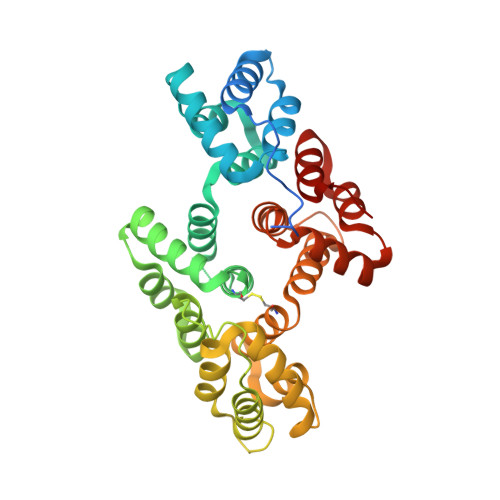The native structure of annexin A2 peptides in hydrophilic environment determines their anti-angiogenic effects.
Raddum, A.M., Hollas, H., Shumilin, I.A., Henklein, P., Kretsinger, R., Fossen, T., Vedeler, A.(2015) Biochem Pharmacol 95: 1-15
- PubMed: 25772737
- DOI: https://doi.org/10.1016/j.bcp.2015.02.013
- Primary Citation of Related Structures:
4X9P - PubMed Abstract:
The progression of aggressive cancer occurs via angiogenesis and metastasis makes these processes important targets for the development of anti-cancer agents. However, recent studies have raised the concern that selective inhibition of angiogenesis results in a switch towards increased tumour growth and metastasis. Since Annexin A2 (AnxA2) is involved in both angiogenesis and metastasis, it may serve as an ideal target for the simultaneous inhibition of both processes. Based on the discovery that domains I (D(I)) and IV (D(IV)) of AnxA2 are potent inhibitors of angiogenesis, we designed seven peptides derived from these domains based on AnxA2 crystal structures. The peptides were expressed as fusion peptides to increase their folding and solubility. Light scattering, far-UV circular dichroism and thermal transition analyses were employed to investigate their aggregation tendencies, α-helical propensity and stability, respectively. 2,2,2-trifluoroethanol (50%) increased the α-helical propensities of all peptides, indicating that they may favour a hydrophobic environment, but did not enhance their thermal stability. D(I)-P2 appears to be the most stable and folded peptide in a hydrophilic environment. The secondary structure of D(I)-P2 was confirmed by nuclear magnetic resonance spectra. The effect of the seven AnxA2 peptides on the formation and integrity of capillary-like networks was studied in a co-culture system mimicking many of the angiogenesis-related processes. Notably, D(I)-P2 inhibited significantly network formation in this system, indicating that the folded D(I)-P2 peptide interferes with vascular endothelial growth factor-dependent pro-angiogenic processes. Thus, this peptide has the potential of being developed further as an anti-angiogenic drug.
Organizational Affiliation:
Department of Biomedicine, University of Bergen.
















